Smile
SMILE is running on a femtosecond laser to reshape the cornea. This femtosecond laser is an extremely short-pulsed, near-infrared laser often also used to create a LASIK flap. The laser’s high peak intensity over a very short pulse duration (within a few femtoseconds of time) allows it to create micro-precision single holes (bubbles) that forms together cuts or planes in the corneal tissue without affecting the surrounding tissue.
It takes less than 30 seconds for the laser to create a small lens-shaped piece of corneal tissue (called the lenticule) inside the cornea. The surgeon then removes the lenticule through a small incision outer part of the eye. This reshapes the cornea and corrects the refractive error.
The femtosecond laser produces a thin layer just beneath the surface of the eye, and at the same time creates a small opening. It’s an almost silent, noiseless, odourless procedure and the patient can remain in the same position from start to finish.

Benefits
Femtosecond lasers are designed to harmlessly pass through the upper layers of the cornea, to create the lenticule only at a specific sublayer inside the cornea, which means:
- With an incision smaller than 4mm on the eye surface, SMILE supports a minimally invasive procedure .
- The outer layer of the cornea doesn’t have to be removed.
- Corneal nerves stimulating the tear glands are less affected and are still able to help keep the eye lubricated. Side effects, such as dry eye syndrome, are rare after SMILE.
- Maintaining the corneal stability is supported, because the entire upper layers of the cornea are virtually unaffected.
Preparing for Surgery
- Stop wearing hard contact lenses for at least four weeks and soft lenses for one week before surgery, because they may interfere with preoperative diagnostic tests.
- Don’t make-up, perfume or lotion the day before and on the day of the procedure. These products may leave debris around the eye and eyelashes, which increases the chance of infection.
- Arrange for alternative transportation directly after the surgery and possibly for the next few days following surgery.
